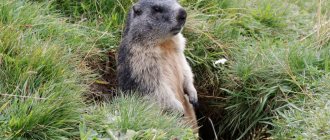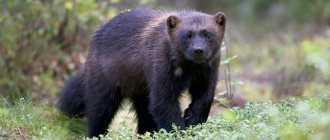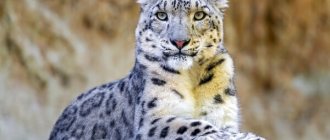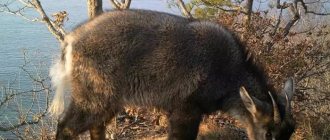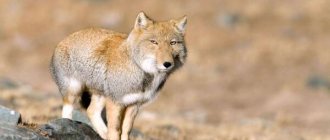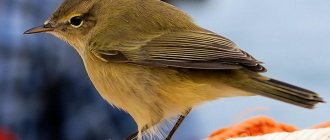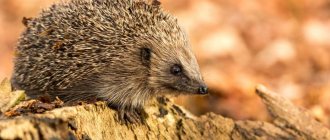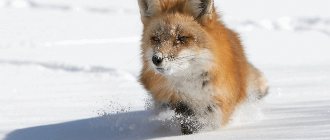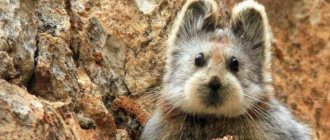- Wild animals
- >>
- Mammals
Tarbagan is a rodent of the squirrel family. The scientific description and name of the Mongolian marmot - Marmota sibirica, was given by the researcher of Siberia, the Far East and the Caucasus - Radde Gustav Ivanovich in 1862.
Origin of the species and description
Photo: Tarbagan
Mongolian marmots are found in the Northern Hemisphere, like all their brothers, but their habitat extends to the southeastern part of Siberia, Mongolia and northern China. It is customary to distinguish two subspecies of tarbagan. Common or Marmota sibirica sibirica lives in Transbaikalia, Eastern Mongolia, and China. The Khangai subspecies Marmota sibirica caliginosus is found in Tyva, western and central Mongolia.
Tarbagan, like the eleven closely related and five extinct species of marmots existing in the world today, emerged from a branch of the genus Marmota from Prospermophilus in the late Miocene. Species diversity in the Pliocene was wider. The European remains date from the Pliocene, and the North American remains from the late Miocene.
Modern marmots have retained many special features of the structure of the axial skull of Paramyidae of the Oligocene era than other representatives of terrestrial squirrels. Not direct, but the closest relatives of modern marmots were the American Palearctomys Douglass and Arktomyoides Douglass, who lived in the Miocene in meadows and sparse forests.
Video: Tarbagan
In Transbaikalia, fragmentary remains of a small marmot from the Late Paleolithic period, probably belonging to Marmota sibirica, were found. The most ancient ones were found on Mount Tologoy south of Ulan-Ude. Tarbagan, or as it is also called, the Siberian marmot, is closer in characteristics to the boibak than to the Altai species, and it is even more similar to the southwestern form of the Kamchatka marmot.
The animal is found throughout Mongolia and the adjacent regions of Russia, also in the northeast and northwest of China, in the Nei-Menggu Autonomous Region bordering Mongolia (the so-called Inner Mongolia) and Heilongjiang Province, which borders Russia. In Transbaikalia it can be found along the left bank of the Selenga, right up to Gusinoye Lake, in the steppes of southern Transbaikalia.
In Tyva it is found in the Chui steppe, east of the Burhei-Murei River, in the southeastern Sayan Mountains north of Lake Khubsugul. The exact boundaries of the range in places of contact with other representatives of marmots (gray in the Southern Altai and Kamchatka in the Eastern Sayan Mountains) are not known.
Marmot
The marmot is a mammal that belongs to the order of rodents from the squirrel family. Representatives of the species weigh several kilograms and live in open spaces. Extremely social herbivores, wrapping themselves in warm fur and hiding in burrows from the hot steppes to the cold mountains. There are many classifications of these cute animals, which will be discussed further.
Determining the origins of marmots has been a challenge for scientists, but they have been able to solve the mystery through analysis of fossil records and modern equipment. At the moment, there are the following common types of marmots: Bobak group: gray, Mongolian, living in the steppe and forest-steppe; Gray-haired; Black-capped; Yellowbellied; Tibetan; Alpine subspecies: broad-faced and nominative; Talas (Menzbir's marmot); Woodchuck - has 9 subspecies; Olympic (Olympic).
These species belong to the order of rodents, of which there are more than two hundred thousand, which cover the entire territory of the planet, except for some islands and Antarctica. It is believed that rodents arose about 60-70 million years ago, but some argue that they originated as early as the Cretaceous period.
About 40 million years ago, the ancient ancestor of marmots arose at the beginning of the Oligocene, after an evolutionary leap and the emergence of new families. It is assumed that marmots are the closest relatives of squirrels, prairie dogs and various flying squirrels. At this time they had a primitive structure of teeth and limbs, but the perfection of the design of the middle ear speaks of the importance of hearing, which has survived to this day.
The steppe marmot or bobak from the bobak group is almost the largest of the squirrel family, because its length is 55-75 centimeters, and the weight of males is up to 10 kg. It has a large head on a short neck and a voluminous body. The paws are incredibly strong, with large claws that are hard to miss. A special feature is a very short tail and a sandy yellow color, which turns into dark brown on the back and tail.
The next representative of the “baibach” group is the gray marmot, which, unlike the steppe marmot, has a shorter stature and a short tail, although it is difficult to distinguish. But this is still possible, because the gray one has softer and longer hair, and the head is darker.
The third member of the group is the Mongolian or Siberian marmot. It differs from its relatives in its much shorter body length, which is a maximum of 56 and a half centimeters. The color of the back fur is dark with black-brown ripples. The belly is black or black-brown, like the back.
The last representative of the bobak group is the forest-steppe marmot. It is described as a rather large rodent, sixty centimeters in length and a tail of 12-13 cm. The back is yellow, sometimes with admixtures of black. There is quite a lot of fur near the eyes and cheeks, which protects the eyes from dust and small particles carried by the wind.
The gray marmot is called not because of its tendency to lose coat color as it gets older, but because of the gray coloration on its upper back. Quite long, reaching 80 cm with a large tail of 18-24 cm. Weight is constantly changing: from 4 to 10 kg, thanks to long hibernation. Females and males are very similar in appearance, but differ in size.
The woodchuck from North America is quite small, because its length ranges from 40 to more than 60 centimeters and weighs 3-5 kg. Males, as among gray-haired marmots, are similar to females, but larger in size. The paws are similar to steppe marmots: short, strong, well adapted for digging. The tail is fluffy and flat, 11-15 cm. The fur is coarse, having an insulating undercoat with a red color.
The steppe marmot, also known as the bobak, in the distant past lived in the steppe, and sometimes in the forest-steppe, from Hungary to the Irtysh, while bypassing the Crimea and the Ciscaucasia. But due to the plowing of virgin lands, the habitat area was greatly reduced. Large populations remain in the Lugansk, Kharkov, Zaporozhye and Sumy regions in Ukraine, in the Middle Volga region, the Urals, in the Don basin and some areas in Kazakhstan.
alpine marmot
The gray marmot, unlike its close relative, chooses more rocky areas, near meadows and river valleys. Subsequently, he settled in Kyrgyzstan, China, Russia, Mongolia and Kazakhstan. The Mongolian marmot lives up to its name and covers almost the entire territory of Mongolia. The habitat also extends to Northeast China. Some researchers suggest its presence in the Northwestern part of the Land of the Rising Sun. On the territory of Russia it is found in Tuva, Sayan and Transbaikalia.
The gray marmot lives on the neighboring continent of North America, most often Canada and the Northeastern states of the United States. Prefers mountains, but in northern Alaska it descends closer to the sea. Occupies alpine meadows, mostly not covered with forest, but with rocky outcrops.
The woodchuck has settled a little to the west, but prefers plains and forest edges. The most common groundhog in the United States: the northern, eastern and central states are practically under their jurisdiction. Also, some representatives of the species climbed into central Alaska and the south of Hudson Bay. Some animals inhabited the Labrador Peninsula.
alpine marmots
Forest-steppe marmots occupy much less land than all others. They have been preserved in the Altai Territory, Novosibirsk and Kemerovo regions. They like to dig holes in which they live, near steep slopes, streams, and sometimes large rivers. Places planted with birch and aspen trees, as well as a wide variety of grass, are attractive.
Baibaks, like all marmots, feed on plants. Among them, they prefer oats, which are found in the steppe, and not from human fields, which does not make them pests. Other agricultural crops are also rarely touched. Sometimes they feast on clover or bindweed. It all depends on the season. In the spring, when food is scarce, they eat plant roots or bulbs. In captivity they eat meat, even from relatives.
Gray marmots are also vegetarians, but in captivity they have not been observed to eat animal meat, especially representatives of the same species. Young shoots are preferred from plant foods. Sometimes they do not disdain leaves, even trees. Some romantic natures prefer flowers that can be brought to the opposite sex, just like in humans, but as food.
The diet of woodchucks is more varied, because they climb trees and swim across rivers for food. They mainly eat plantain and dandelion leaves. Sometimes they hunt snails, beetles and grasshoppers. In the spring, when there is little food, they climb apple, peach, and mulberry trees and eat young shoots and bark. In vegetable gardens they may catch peas or beans. Water is obtained from plants or by collecting morning dew. They don't stock up on anything for the winter.
In many ways, the diet of marmots is similar, but some foods that are native to certain regions differ. Some can attack people's gardens, and some eat the meat of their relatives in captivity. But what they have in common is that the basis of their diet is plants, in particular their leaves, roots, and flowers.
Baibaks, after emerging from hibernation, fatten up and begin to repair their burrows. The activity begins immediately at sunrise and ends only at sunset. The animals are very social: they post sentries while others feed. In cases of danger, they inform others about the impending threat, and everyone hides. Quite peaceful creatures that rarely fight.
Gray marmots are also diurnal creatures, known to feed on plants. Their colonies are very large and often exceed 30 individuals. Thus, this entire herd occupies 13-14 hectares of land and has a leader: an adult male marmot, 2-3 females and a large number of young marmots up to two years old. The burrows are simpler than those of bobaks and consist of one hole 1-2 meters deep. But their number exceeds a hundred.
Woodchucks are very careful and rarely move away from their burrows. Summer shelters are set up in well-lit areas. Winter burrows are hidden in forests on hillsides. Unlike gray marmots, forest marmots build a complex structure of burrows, which sometimes have more than 10 holes and 300 kg of discarded earth. They lead a sedentary, antisocial lifestyle.
The way of life depends more on the territory in which marmots live than the food they eat. Some live with females separately from each other, and some flock together in entire armies of 35 individuals. Some dig simple holes, while others plan intricacies, paying attention to emergency exits and restrooms.
At the beginning of spring, the mating season begins for boibaks. The duration of pregnancy is just over a month. 3-6 cubs are born. Newborns are very small and defenseless, so parents take care of them very carefully in the first stages of life. Females drive males into other burrows for the feeding period. At the end of spring, small bobwhites begin to feed on grass.
Female gray marmots give birth to 4 to 5 cubs a little later than boibaks - this event occurs in late spring or early summer. Pregnancy also lasts about a month. The children of gray-haired marmots are earlier and in the third week they already come to the surface, having fur and beginning to wean themselves from feeding with milk.
If female gray marmots allow males to help them during pregnancy, and female boibaks drive males into other burrows, then pregnant woodchucks are extremely aggressive and even members of their flock have to flee. It’s no wonder that the males immediately leave after conception, or rather drive them away.
Forest-steppe marmots are more loyal to each other and hibernate, even letting their neighbors into their burrows. Sometimes they do not interfere with uninvited guests in the form of badgers or other animals. The females of these friendly animals give birth to 4-5 cubs, and sometimes even 9!
Marmots themselves do not pose a danger to anyone; in rare cases, insects or snails may be unlucky. Therefore, they are hunted by all predators that can meet them. The unenviable position of marmots is worsened by the fact that they do not possess any physical characteristics: speed, strength, maneuverability, poison, etc. But most often what saves them is their group intelligence and caring for each other.
Baibaks can die in the mouth of a wolf or a fox, which can climb into a hole. On the surface, while feeding or warming up in the sun, birds of prey can attack: eagle , hawk, kite. Also, steppe marmots often become prey for corsacs, badgers and ferrets , which, millions of years ago, originated together with marmots from the same ancestor. Woodchucks are also susceptible to a wide range of dangerous predators. Others are added to all those mentioned: pumas; lynx; martens; the Bears; birds; big snakes.
Small predators can attack cubs in burrows. Although in most agricultural areas they are under little threat because humans destroy or drive away their enemies. But then stray dogs are added to the list of threats. Therefore, the prospects for marmots are not bright. In addition to the destructive activities of humans, many animals hunt harmless animals. Because of this, many species, such as forest-steppe marmots, are experiencing severe decline, and the task of humans is to prevent this.
Marmots are a numerous species, spread over large parts of the planet. They live in different conditions and have developed different skills of social communication, raising offspring, obtaining food and, most importantly, protection from local predators who are eager to send them to the next world. All this affected the territory of settlement of representatives of the species and their number.
Baibaks are not an endangered species, although their numbers decreased greatly in the 40-50s of the last century. Thanks to coordinated actions, it was possible to stop the disappearance of these animals. Although in some regions they are on the verge of extinction. The symbol of the Lugansk region was included in the Red Book of the Kharkov region in Ukraine and the Ulyanovsk region in Russia in 2013.
Mongolian marmots are also rare and are listed in the Red Book of Russia. It is estimated that there are only about 10 million of them left, which is an extremely small number. Conservation and restoration activities regarding the species are complicated by the fact that they are carriers of plague.
North American Residents: Gray and gray marmots only increase their population over time. This happens because they have learned to adapt to people better than other marmots. Plowing the soil, which has led to a reduction in bobbacks, only increases food supplies. Also, in times of famine, they feed on plants that grow in gardens, orchards and fields.
Some marmots need to be carefully protected so as not to allow them to disappear, some simply do not interfere, and they will recover on their own, some have learned to adapt to human harm, others even benefit from it. Therefore, such a strong differentiation of species depends on the initial characteristics and the ability to adapt to new conditions.
Marmots are vegetarians, eating leaves, roots and flowers of plants, although some eat meat in captivity. Some of them live in large flocks, while others prefer solitude. They live on most continents of the Earth in separate species populations. At first glance they are so similar, but upon closer examination they are so different.
Share link:
Appearance and features
Photo: What Tarbagan looks like
The length of the carcass is 56.5 cm, the tail is 10.3 cm, which is approximately 25% of the body length. The length of the skull is 8.6 – 9.9 mm, it has a narrow and high forehead and wide cheekbones. In the tarbagan, the postorbital tubercle is not as pronounced as in other species. The coat is short and soft. The color is gray-yellow, ocher, but upon closer examination it dazzles with dark chestnut tips of the guard hairs. The lower half of the carcass is reddish-gray. On the sides the color is fawn and contrasts with both the back and belly.
The top of the head is colored darker and looks like a cap, especially in the fall, after molting. It is located no further than the line that connects the middle of the ears. The cheeks, where the vibrissae are located, are light and their color area merges. The area between the eyes and ears is also light. Sometimes the ears are slightly reddish, but more often they are gray. The area under the eyes is slightly darker, and around the lips it is white, but there is a black border in the corners and on the chin. The tail, like the color of the back, is dark or gray-brown at the end, as is its underside.
The incisors of this rodent are much better developed than the molars. Adaptation to life in burrows and the need to dig them with paws affected their shortening; the hind limbs were especially modified in comparison with other squirrels, especially chipmunks. The fourth finger of the rodent is more developed than the third, and the first forelimb may be absent. Tarbagans do not have cheek pouches. The weight of the animals reaches 6-8 kg, reaching a maximum of 9.8 kg, and by the end of summer, 25% of the weight is fat, about 2-2.3 kg. Subcutaneous fat is 2-3 times less than abdominal fat.
Tarbagans in the northern regions of their range are smaller in size. Larger and darker-colored individuals are found in the mountains. Eastern specimens are lighter; the further to the west, the darker the color of the animals. M. s. sibirica is smaller and lighter in size with a more distinct dark “cap”. M. s. caliginosus is larger, the top is colored in darker tones, up to chocolate brown, and the cap is not as pronounced as in the previous subspecies, the fur is slightly longer.
Where does the tarbagan live?
Photo: Mongolian tarbagan
Tarbagans are found in foothill and alpine meadow steppes. Their habitats with sufficient vegetation for grazing are: grasslands, shrubs, mountain steppes, alpine meadows, open steppes, forest steppes, mountain slopes, semi-deserts, river basins and valleys. They can be found at altitudes of up to 3.8 thousand m above sea level. m., but they do not live in purely alpine meadows. Also avoid salt marshes, narrow valleys and hollows.
In the north of the range they settle along the southern, warmer slopes, but can occupy forest edges on the northern slopes. Favorite habitats are foothill and mountain steppes. In such places, the diversity of the landscape provides the animals with food for a fairly long period. There are areas where the grasses turn green early in the spring and shady areas where the vegetation does not burn out for a long time in the summer. In accordance with this, seasonal migrations of tarbagans occur. The seasonality of biological processes affects the activity of life and reproduction of animals.
As the vegetation burns out, migrations of tarbagans are observed, the same can be observed in the mountains, depending on the annual shift of the moisture belt, feeding migrations take place. Vertical movements can be 800-1000 meters in height. Subspecies live at different altitudes M. s. sibirica occupies the lower steppes, and M. s. caliginosus rises higher on mountain ridges and slopes.
The Siberian marmot prefers the steppes:
- mountain cereals and sedges, less often wormwood;
- forbs (dancing);
- feather grass, chamomile, with an admixture of sedges and forbs.
When selecting a habitat, tarbagans choose those where there is a good view - in short-grass steppes. In Transbaikalia and eastern Mongolia, it settles in the mountains along smoothed gorges and ravines, as well as along hilly areas. In the past, the habitat borders extended to the forest zone. Now the animal is better preserved in the inaccessible mountainous region of Khentei and the mountains of western Transbaikalia.
Now you know where tarbagan is found. Let's see what the groundhog eats.
What does the tarbagan eat?
Photo: Marmot Tarbagan
Siberian marmots are herbivores and eat green parts of plants: cereals, asteraceae, and moths.
In western Transbaikalia, the main diet of tarbagans is:
- tansy;
- fescue;
- kaleria;
- sleep-grass;
- buttercups;
- astragalus;
- skullcap;
- dandelion;
- scabious;
- buckwheat;
- bindweed;
- cymbaria;
- plantain;
- chamomile;
- bentgrass;
- wheatgrass;
- also various types of wild onions and wormwood.
Interesting fact: When kept in captivity, these animals ate well 33 species of plants out of 54 that grow in the steppes of Transbaikalia.
There is a change in feed depending on the season. In the spring, while there is little greenery, when the tarbagans emerge from their burrows, they eat the growing turf of grasses and sedges, rhizomes and bulbs. From May to mid-August, having a lot of food, they can eat their favorite asteraceae heads, which contain a lot of proteins and easily digestible substances. From August, and in dry years and earlier, when the steppe vegetation burns out, rodents stop eating grasses, but in the shade, in depressions of the relief, forbs and wormwood are still preserved.
As a rule, the Siberian marmot does not eat animal food; in captivity they were offered birds, gophers, grasshoppers, beetles, and larvae, but the tarbagans did not accept this food. But probably, in case of drought and lack of food, they also eat animal food.
Interesting fact: Plant fruits and seeds are not digested by Siberian marmots, but they sow them, together with organic fertilizer and sprinkling with a layer of soil, this improves the landscape of the steppe.
Tarbagan eats from one to one and a half kg of green mass per day. The animal does not drink water. Marmots meet early spring with an almost unused supply of abdominal fat; like subcutaneous fat, it begins to be used up with increased activity. New fat begins to accumulate in late May - July.
Features of character and lifestyle
Photo: Tarbagan
The lifestyle of the tarbagan is similar to the behavior and life of the boibak, the gray marmot, but their burrows are deeper, although the number of chambers is fewer. More often than not, it's just one big camera. In the mountains, the type of settlements is focal and beam. For the winter, the exit holes, but not the passages in front of the nesting chamber, are clogged with an earthen plug. On hilly plains, for example, as in Dauria, the Bargoi steppe, the Mongolian marmot settlements are evenly distributed over a large area.
Wintering, depending on the habitat and landscape, is 6 - 7.5 months. Mass hibernation in the southeast of Transbaikalia begins at the end of September, the process itself can be extended for 20-30 days. Animals that live near highways or where they are disturbed by humans do not gain fat well and hibernate longer.
The depth of the hole, the amount of bedding and a larger number of animals allows you to maintain the temperature in the chamber at 15 degrees. If it drops to zero, then the animals go into a half-asleep state and with their movements they warm each other and the surrounding space. The burrows that Mongolian marmots have been using for years produce large emissions of soil. The local name for such surchins is butanes. Their size is smaller than that of bobak or mountain marmots. The greatest height is 1 meter, the crossbar is about 8 meters. Sometimes you can find more massive marmots - up to 20 meters.
In cold, snowless winters, tarbagans that have not accumulated fat die. Exhausted animals also die in early spring, when there is little food or during snowstorms in April-May. First of all, these are young individuals who have not had time to gain fat. In spring, tarbagans are very active, they spend a lot of time on the surface, moving far from their burrows, to where the grass is green for 150-300 meters. They often graze on marmots, where the growing season begins earlier.
On summer days, the animals stay in burrows, rarely coming to the surface. They come out to feed when the heat subsides. In autumn, fattened Siberian marmots lie on marmots, but those who have not gained fat graze in depressions in the relief. After the onset of cold weather, tarbagans rarely leave their burrows, and even then, only in the midday hours. Two weeks before hibernation, animals begin to actively prepare bedding for the winter chamber.
Lifestyle
Marmots unite to live in small colonies. They consist of a married couple and their offspring born in the previous two to three years. If there is enough food in the area of their habitat, then the colony can contain up to 18 individuals, and if there is not enough food, the number decreases by three to four times.
When there is insufficient food, tarbagans carefully guard their possessions and do not allow other marmots into them. If there is enough food, then they calmly tolerate the presence of neighbors and are not aggressive.
Animals communicate using specific sounds. If a predator approaches, the tarbagan makes a whistling sound. When there is an alarm signal, all the animals run to their holes and hide.
Tarbagans build deep burrows. The hole is made in the form of one large chamber. In winter, the exit is closed with a plug of mud and grass. There are earthen mountains near the burrows of Mongolian marmots. They are called surchins (butanes). Surchins reach a height of up to one meter, and are 8 or more meters in diameter.
The tarbagan emerges from its burrow in the evening to eat. By autumn, marmots that have accumulated enough fat rest on the surface of marmots, and those that have not accumulated fat accumulations graze on grasses.
When cold weather sets in, tarbagans practically do not leave their burrows. Before hibernation, the animals prepare bedding in the winter chamber. In winter they hibernate.
Social structure and reproduction
Photo: Tarbagan from the Red Book
The animals live in the steppes in colonies, communicating with each other by sounds and monitoring the territory visually. To do this, they sit on their hind legs, looking around at the world around them. For a wider view, they have large, bulging eyes that are placed higher on the top of the head and further on the sides. Tarbagans prefer to live on an area of 3 to 6 hectares, but under unfavorable conditions they will live on 1.7 - 2 hectares.
Siberian marmots use burrows for several generations if no one bothers them. In mountainous regions, where the soil does not allow digging many deep holes, there are cases when up to 15 individuals hibernate in one chamber, but on average 3-4-5 animals hibernate in holes. The weight of the litter in the winter nest can reach 7-9 kg.
The rut, and soon fertilization, occurs in Mongolian marmots after awakening in winter burrows, before they emerge to the surface. Pregnancy lasts 30-42 days, lactation lasts the same amount. Marmots, after one week, can suck milk and eat vegetation. There are 4-5 babies in the litter. The sex ratio is approximately equal. In the first year, 60% of the offspring die.
Young marmots do not leave their parents' burrows until they are three years old or until they reach sexual maturity. Other members of the extended family colony also participate in child rearing, mainly in the form of thermoregulation during hibernation. This alloparental care increases the overall survival of the species. Under stable conditions, a family colony consists of 10-15 individuals, and under unfavorable conditions, 2-6. About 65% of sexually mature females participate in reproduction. This species of marmot becomes suitable for procreation in the fourth year of life in Mongolia and in the third in Transbaikalia.
Interesting fact: In Mongolia, hunters call underyearlings “mundal”, two-year-olds – “kotel”, three-year-olds – “sharahatszar”. An adult male is called “burkh”, a female is called “tarch”.
Reproduction
Marmots breed in the colony where they live. It happens that families are formed outside the colony. Reproduction can be carried out from the age of three, although tarbagans reach sexual maturity by two years.
Mating takes place in burrows in the first ten days of April. In females, pregnancy lasts approximately 40 to 42 days. Offspring appears in the amount of 4-8 cubs. Babies are fed on mother's milk for about six weeks. From the month of life they already begin to eat plant foods. In the nesting chamber, both the parents and other marmots living in the hole take care of the cubs.
Natural enemies of tarbagans
Photo: Tarbagan
Of the birds of prey, the most dangerous for the Siberian marmot is the golden eagle, although it is rarely found in Transbaikalia. Steppe eagles hunt sick individuals and marmots, and also eat dead rodents. The Central Asian buzzard shares this food supply with steppe eagles, playing the role of a steppe orderly. Tarbagans attract buzzards and hawks. Of the predatory four-legged animals, wolves cause the greatest harm to Mongolian marmots; the population may also decrease due to attacks by stray dogs. Snow leopards and brown bears can hunt them.
Interesting fact: While the tarbagans are active, wolves do not attack flocks of sheep. After the rodents hibernate, gray predators switch to domestic animals.
Foxes most often lie in wait for young marmots. They are successfully hunted by corsac foxes and light-colored ferrets. Badgers do not attack Mongolian marmots and rodents do not pay attention to them. But the hunters found the remains of marmots in the badger’s stomach; their size suggests that they were so small that they had not yet left the hole. Tarbagans are troubled by fleas, ixodid and lower ticks, and lice living in their fur. Skin gadfly larvae can parasitize under the skin. Animals also suffer from coccidia and nematodes. These internal parasites lead rodents to exhaustion and even death.
Tarbagan is used by the local population for food. In Tyva and Buryatia it is no longer so common (perhaps due to the fact that the animal has become quite rare), but in Mongolia it is everywhere. The meat of the animal is considered a delicacy; the fat is used not only for food, but also for the preparation of medicines. Rodent skins were not previously particularly valued, but modern dressing and dyeing technologies make it possible to imitate their fur as more valuable fur.
Interesting fact: If the tarbagan is disturbed, he never jumps out of the hole. When a person begins to dig it out, the animal burrows deeper and clogs the passage behind itself with an earthen plug. The caught animal desperately resists and can seriously injure, clinging to a person with a death grip.
Enemies of the Mongolian marmot
In nature, the marmot's enemies are representatives of birds of prey such as golden eagles, steppe eagles, hawks, and buzzards. Predatory mammals also love to feast on tarbagan meat. Marmots are hunted:
- wolves;
- snow leopards;
- brown bears;
- foxes;
- light-colored ferrets;
- corsacs.
Harm to tarbagans is caused by lice, fleas and ticks, larvae of skin gadflies, nematodes, and coccidia. Such parasites can lead animals to complete exhaustion or death.
Mongols, Buryats and Tuvans hunt tarbagans, as they use them for food and for making medicine.
Population and species status
Photo: What tarbagan looks like
The Tarbagan population has declined significantly over the last century. This is especially noticeable in Russia.
Main reasons:
- unregulated hunting of the animal;
- cultivation of virgin lands in Transbaikalia and Dauria;
- special extermination to prevent outbreaks of plague (Tarbagan is the carrier of this disease).
In the 30-40s of the last century in Tyva, along the Tannu-Ola ridge, there were less than 10 thousand individuals. In the western Transbaikalia, their number in the 30s was also approximately 10 thousand animals. In southeastern Transbaikalia at the beginning of the twentieth century. There were several million tarbagans, and by the middle of the century in the same areas, in the main distribution area, the number was no more than 10 individuals per 1 km2. Only north of Kailastui station, in a small area, the density was 30 units. per 1 km2. But the number of animals was constantly decreasing, since hunting traditions are strong among the local population.
The approximate number of animals in the world is about 10 million. In 84 of the twentieth century. In Russia there were up to 38,000 individuals, including:
- in Buryatia - 25,000,
- in Tyva – 11000,
- in South-Eastern Transbaikalia - 2000.
Now the number of the animal has decreased many times; it is largely supported by the movement of tarbagans from Mongolia. Hunting of the animal in Mongolia in the 90s reduced the population here by 70%, transferring this species from “least concern” to “endangered”. According to the recorded hunting data for 1942-1960. It is known that in 1947 the illegal trade reached a peak of 2.5 million units. Between 1906 and 1994, at least 104.2 million skins were prepared for sale in Mongolia.
The actual number of skins sold exceeds hunting quotas by more than three times. In 2004, more than 117 thousand illegally obtained skins were confiscated. There has been a hunting boom since the price of pelts has risen, and factors such as improved roads and transportation provide greater access for hunters to search for rodent colonies.
Security measures
Now on the territory of our country in the Trans-Baikal Territory and Buryatia, the Mongolian marmot is under protection. Two reserves (Sokhondinsky and Daursky) and two reserves (Borgoysky and Orotsky) were created. The animal is listed in the Russian Red Book.
In Mongolia, the tarbagan is listed as a rare species of animal and hunting it is allowed only two months a year. An interesting fact is that monuments to Tabargan were erected in the following cities:
- Krasnokamensk The composition represents two animal figures in the guise of a hunter and a miner.
- Angarsk The sculpture symbolizes the production process of fur hats, which began at the end of the last century.
- Tyva (near the village of Mugur-Aksy). Large composition of two figures of tarbagans.
- Ulaanbaatar and Eastern aimag (the monument is made of traps).
The preservation of tarbagans is necessary because their vital activity has a positive effect on the improvement of the flora. Marmots play a key role for the favorable development of biogeographical zones.
